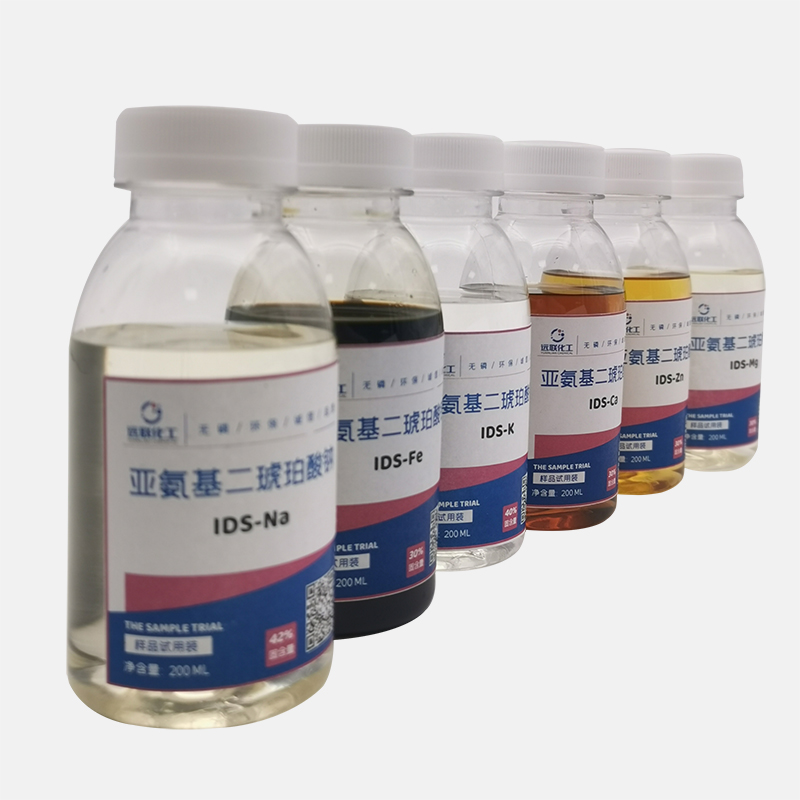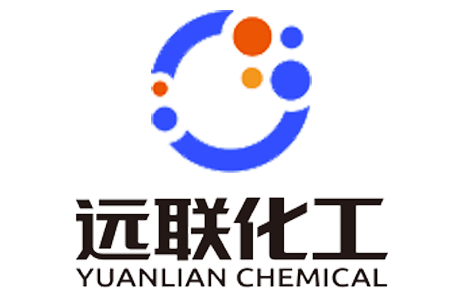
Research progress on properties and applications of green chelating agent iminodisuccinic acid
1 Current status of IDS performance research

1.1 Chelating performance
Experiments show that the chelating ability of IDS for metals such as Mn2+, Zn2+, and Ca2+ has basically reached the level of EDTA, and some even exceed EDTA, such as Cu2+ and Fe3+. Although the chelating ability for metals such as Ba2+, La3+, and Ce3+ is far from the level of EDTA, it still has great development prospects due to its excellent biodegradability.
1.2 Biodegradability
IDS has four isomers, namely RR′-, SS′-, RS′- and SR′-IDS. The study by Reinecke et al. [22] showed that the biodegradability of these four isomers is different. Two of the isomers, RS′- and SR′-IDS, were almost completely degraded in less than two days, while the degradation experiment of the mixture of RR′- and SS′-IDS showed that the degradation rate of the mixture of the two exceeded 50% after 5 days.
IDS not only has a high degradation rate, but also a very fast degradation speed. Basically, within 7 days, 80% of the organic components are destroyed. All these show that it is a truly "environmentally friendly" substance.
1.3 Toxicological properties
Bell Company of the United States has tested the toxicological and ecotoxicological properties of iminodisuccinic acid. Toxicological data: Acute oral toxicity (rat), LD50 > 2 000 mg/kg; acute skin toxicity (rat), LD50 (24 h) > 2 000 mg/kg; acute toxicity (skin irritation), aqueous solution, pH <11.5, non-irritating; skin sensitization, aqueous solution, pH <11.5, non-irritating; subacute oral toxicity (rat), NOEC (28 d) 200 mg/kg·d-1; mutagenicity (Ames test), no elicitor effect (in vitro), negative value; mutagenicity (micronucleus assay), no cleavage agent effect (in vitro), negative value. Ecotoxicology data: acute toxicity (fish), LC0 (96 h) 82.6 mg/kg; acute toxicity (water) EC0 (48 h) 84.0 mg/L; algae inhibition test, ErC50 (72 h) 94.5 mg/L; bacterial inhibition test, EC50 (0.5 h) 10 000 mg/L; biodegradability (OECD 301 E), DOC removal rate (28 d) is 79%, easy to degrade; biodegradability (OECD 302 B), DOC removal rate (28 d) is 89%.
From the above data, it can be concluded that IDS has low toxicity, no teratogenic effect, low skin irritation, non-toxic and harmless to the ecosystem, and is an environmentally friendly chelating agent.
2. Current status of IDS application research
Due to its excellent chelating properties and degradation ability, IDS has been widely used in soil heavy metal pollution extraction, membrane cleaning, civil detergents, industrial cleaning agents, dyeing and finishing processes, textile industry, papermaking industry, photosensitive materials, ceramic technology, soil heavy metal pollutant extraction, agricultural trace element fertilizer [23], and is also used as a scale inhibitor, water softener and oxygen bleaching stabilizer.
2.1 Treatment of soil heavy metal pollution
Due to the intensification of industrial activities and the unreasonable discharge of industrial waste, the content of trace elements in the soil will be too high, which will affect the development of crops, reduce food production, and even endanger human health.
Phytoremediation technology is a new technology that has emerged in recent years. It uses hyperaccumulators to enrich and transport excessive heavy metal elements in the soil to the harvestable parts of the plant roots and the aboveground stems and leaves (especially the aboveground parts), thereby repairing the soil.
Wallace first discovered in 1974 that adding chelating agents such as EDTA and NTA to the soil can enhance the absorption of heavy metals by plants. At present, chelation-induced phytoremediation has become a hot topic in the study of phytoremediation of heavy metal-contaminated soil. Chelation-induced technology activates heavy metals in the soil by applying chelating agents to the soil, increases the concentration of heavy metals in the soil solution, and enhances the absorption of heavy metals by plants to improve the efficiency of phytoremediation. Studies have found that among chelating agents such as EDTA, NTA, HEDTA, and DTPA, EDTA chelation-induced plant extraction of heavy metals has the best effect, but EDTA chelating agents are not easily biodegradable; IDS has a similar performance in chelating metal ions in the soil as EDTA, and is even stronger than EDTA for some specific metals, and is degradable, so it is expected to be used for the extraction of heavy metals in the soil.
2.2 Fabric bleaching
The purpose of bleaching cotton/linen fabrics is mainly to remove natural pigments in the fiber and improve the whiteness of the fabric. Bleaching agents need to be added during the bleaching process. Studies have shown that adding IDS to the bleaching of cotton/linen fabrics can effectively chelate metal ions, reducing their catalytic decomposition of hydrogen peroxide, thereby increasing the whiteness, hair effect and strength of the fabric. The study by Su Xiafei et al. [29] also confirmed that IDS can effectively inhibit the decomposition of hydrogen peroxide and can be used normally under the condition of 40 g/L alkali mass concentration.
2.3 Pulp bleaching
Studies have shown that when bleaching pulp, if a chelating agent is added in advance to remove most of the transition metal ions, the rapid decomposition of H2O2 can be reduced. The study compared the effects of EDTA and IDS as chelating agents on pulp bleaching. The results showed that the effects of IDS and EDTA are similar, but because of the excellent biodegradability of IDS, it is expected to be used in the H2O2 bleaching process of pulp.
2.4Washing aids
The cleaning agent containing sodium IDS is significantly better than the standard cleaning agent without sodium IDS when cleaning diesel oil filled on polyamide nanofiltration membrane and silicone oil filled on polyphenylene ether sulfone ultrafiltration membrane.
In addition, IDS can also be used in soap formulations, which have stronger detergency than soaps without IDS, mainly because the addition of chelating agents can effectively shield the effect of metal ions on the washing effect of detergents. IDS can also be used in dishwashing detergent formulations. The experiment tested its effectiveness as a machine dishwashing detergent formulation and found that compared with other detergent formulations, the detergent with IDS added had the least precipitation on the stainless steel surface after washing and had a higher efficiency in secondary washing.
2.5 Micro-fertilizer
Micro-fertilizer is a fertilizer that provides trace elements for plants, such as copper fertilizer, boron fertilizer, manganese fertilizer, iron fertilizer, zinc fertilizer, etc. are all called micro-fertilizers. Traditionally, trace elements are supplemented in the form of inorganic salts, such as zinc sulfate, ferrous sulfate and manganese sulfate, but the fertilization efficiency is low, it is easy to lose, and it is not conducive to crop absorption. Moreover, due to the soil itself, it not only fails to supplement trace elements, but also causes soil compaction, which is not conducive to environmental protection and sustainable agricultural development. Therefore, improving the effectiveness of micro-fertilizers in balanced fertilization is a key issue in the application of micro-fertilizers.
In summary, the chelating ability of IDS for metals such as Mn2+, Zn2+, and Ca2+ has basically reached the level of existing chelating agents, and some even exceed existing chelating agents. The stability of the chelates formed by IDS and metal ions is also relatively high; IDS has low toxicity, no teratogenic effect, and low skin irritation; it has good biodegradability and excellent environmental compatibility; it is currently used in many industries.
In view of its good performance, it can be promoted and applied to more fields to replace existing chelating agents; or its derivatives can be synthesized to obtain some functional products with multiple functions, such as chelating surfactants.
Shandong Yuanlian Chemical Co.,ltd. is one of the top manufactures of Iminodisuccinic acid (IDS, IDHA) and related metal salts in China, any needs for MSDS, TDS, COA of MGDA, feel free to contact: [email protected]; Tel: +86 537 3739818
Yuanlian Chemical specializes in the production of polyaspartic acid (PASP),tetrasodium iminodisuccinate(IDS), GLDA, MGDA etc. with stable quality and excellent quantity!




Contact us